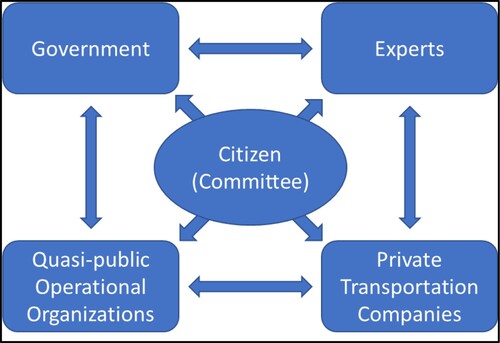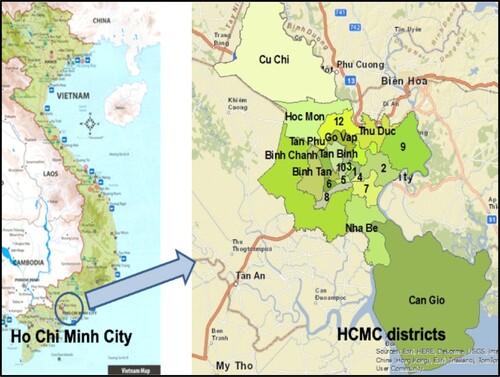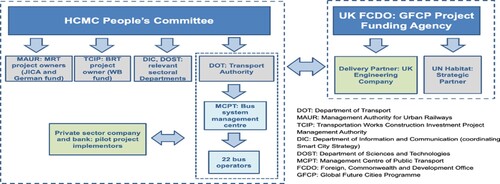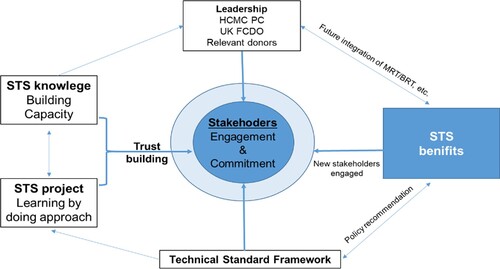ABSTRACT
Smart city initiatives have the potential to address many contemporary urban challenges, utilizing information and technology. Increasingly, smart cities are considered as social innovation processes to achieve sustainable and inclusive urban development, being influenced by broader socio-economic and institutional contexts of cities. This paper explores ‘smart city transitions’ across varied urban contexts, in particular, how smart city transitions are enacted and how they contribute to inclusive urban transformation and public value. Using a multiple case studies approach, the research investigated infrastructure planning practices in Amsterdam in the Netherlands, Seoul in Korea, Portland in the U.S. and Ho Chi Minh City (HCMC) in Vietnam, cities that were known for strong efforts to establish integrated platforms to enhance societal benefits. Our analysis showed that each city has addressed its goals around sustainability, equity and affordability by reinforcing the engagement of multiple actors with the support of integrated platforms that facilitate open and multi-directional information flow in a transparent manner. In Amsterdam, innovative solutions for sustainable use of resources have been invented and distributed through multi-level social networks, contributing to the transformation into a circular economy. In Seoul and HCMC, the city's persistent efforts to utilize an open and integrated platform resulted in proactive engagement and collaboration of public and private actors in improving quality, equity and efficiency of transit services. Portland has tackled inequitable access and mistrust issues by setting principles for data governance and facilitating equity in the adoption of innovative technologies. Our research revealed that four cities established different forms of integrated platforms such as a centrally-controlled platform and a community-centred platform in order to address specific socio-economic issues within an institutional setting of each city. We concluded that building an integrated platform is not easy, but it is a critical prerequisite for the process of sustainable transformation to truly achieve smart cities across the globe.
Highlights
Smart city transformations are socio-cultural and organizational processes.
Smart city processes do not follow black and white logic.
An integrated open platform can be middleware to enable collective governance.
Smart city transitions account for existing socio-economic and institutional contexts.
Multi-level governance in smart cities is critical for inclusive urban transformation.
1. Introduction
In the twenty-first century, cities serve as a major organizing mechanism for human development – one that relies on community interdependence and gains in resource efficiency to ensure long-term sustainability (Raven et al., Citation2019). At the same time, there is a lot of compounding pressure on our cities, with the growing pains of rapid urbanization and densification, uncertainty and hazard extremes linked to climate change and deepening socio-economic disparities (Lee, Arts, & Vanclay, Citation2020; UN-Habitat, Citation2019b).
Smart city initiatives are emerging as potential solutions to contemporary urban challenges, by enhancing our collective ability to plan and respond. By utilizing information and communication technologies to strengthen relationships between the public and the built environment, improvements in governance are possible in both function and form (Kang & Lee, Citation2015). Much of the research on smart cities has focused on clarifying ideas underpinning smart cities or discussing what smart cities should or should not be (Cardullo & Kitchin, Citation2019; Cowley, Joss, & Dayot, Citation2018; Joss, Sengers, Schraven, Caprotti, & Dayot, Citation2019). Such discussions concentrated on what is right and wrong, rather than many ways that smart city initiatives contribute to solving wicked, system-wide issues facing cities. There is a need for expanding the debate beyond the conceptualization of smart cities and instead focus on application and experimentation through real-life case studies (Luque-Ayala & Marvin, Citation2015; Shelton, Zook, & Wiig, Citation2015).
Increasingly, smart city transformations are considered as socio-cultural processes to achieve more sustainable and inclusive urban development, rather than static outcomes (Giffinger & Lü, Citation2015; Meijer & Thaens, Citation2018; UN-Habitat, Citation2019b). Noori, Hoppe, and de Jong (Citation2020) emphasized that ‘smart’ has a strong connotation to not only technological, but also organizational and social innovation (processes). Smart city development can be a fruitful process in and of itself to advance self-organization, integration and transparency (de Lange & de Waal, Citation2019; March, Citation2018; McFarlane & Söderström, Citation2017). More open and integrated data collection and management, citizen engagement, and infrastructure and digital technology application together make cities more inclusive and resilient and, hence, able to respond more quickly to new challenges (Castelnovo, Misuraca, & Savoldelli, Citation2016).
Mosannenzadeh and Vettoriato (Citation2014) stressed that any investigation into smart city transitions should be able to account for the contextual impetus and drivers for making a city smarter, rather than focusing on the pre-defined logic of smart city in the abstract. There is a clear need for critical (re)assessment of smart city transitions contextualized to the socio-economic agenda, adoption of technology and institutional structures (Raven et al., Citation2019).
This research addressed the gaps in nuanced understanding of ‘smart city transitions’ from actual practices. In particular, we focused on how urban actors attempt to realize smart cities contributing to facilitating inclusive urban transformation, across varied urban contexts. We do this by using a multiple case studies approach. The research investigated infrastructure planning practices in Amsterdam in the Netherlands, Seoul in South Korea, Portland in the U.S. and Ho Chi Minh City (HCMC) in Vietnam, all of which are known for strong efforts to establish integrated platforms to make a smart city with an aim to enhance public benefits. It examined multiple ways that smart city transitions were enacted and then reflected on commonalities and context-specific processes and elements enabling smart city transitions.
2. Literature review
Smartness is often identified with a general concept of innovation and with a substantial use of technologies (OECD, Citation2019). Many scholars (e.g. Hollands, Citation2015; Luna-Reyes & Gil-Garcia, Citation2014) claim that smart cities impose technological determinism and underestimate the factors involved at the societal, organizational, individual and cultural levels.
Increasingly, some studies have started to investigate how smart city initiatives shape the wider processes of urban transformation (Bulkeley et al., Citation2016; Evans, Karvonen, & Raven, Citation2016; Haarstad & Wathne, Citation2019). Scholarship in transition studies defined experiments of smart cities as ‘inclusive, practice-based initiatives designed to promote system innovation through social learning’ (Sengers, Spaeth, & Raven, Citation2018). In urban contexts, experimental practices have been suggested to be open-ended, contingent, being characterized by multiplicity (e.g. Bulkeley et al., Citation2016; Caprotti & Cowley, Citation2016).
Smart city transitions can facilitate open ecosystems, in which citizens and other relevant stakeholders are collaboratively involved in the co-creation of innovations that improve life in the city and boost the local economy (de Lange & de Waal, Citation2019). Integrated platforms that facilitate open and multi-dimensional information flow among actors contribute to triggering collective governance by increasing the connectivity and density of social networks (Kourtit, Elmlund, & Nijkamp, Citation2020; PWC, Citation2019; Repette, Sabatini-Marques, Yigitcanlar, Sell, & Costa, Citation2021). Municipal governments, entrepreneurs and citizens increasingly collaborate at multiple levels to test innovative approaches to sustainable and equitable energy production, mobility, housing and other service provisions (Cowley & Caprotti, Citation2019; Joss et al., Citation2019).
Emerging scholarly discussions on smart city transitions (e.g. Cowley et al., Citation2018; Joss et al., Citation2019; Luque-Ayala & Marvin, Citation2015) argued that the transitions are far from uniform in time and space and vary in their hybrid formations which are clearly conditioned by existing urban trajectories and local contexts (Joss et al., Citation2019; Luque-Ayala & Marvin, Citation2015). Cowley et al. (Citation2018) stressed that smart cities represent varied forms of governance arrangements (e.g. citizen-driven open-ended process, government-driven goal-targeted process) that address pre-existing strategic concerns of cities, challenging the simple categorization of smart cities. The transitions cannot be understood independent of their broader, multi-scalar situatedness, which has to be empirically explored (Coenen, Benneworth, & Truffer, Citation2012; Karvonen & van Heur, Citation2014).
In practice, smart city transitions are closely related to their unique and concurrent city contexts such as emergent social and economic issues, incumbent actor networks, institutional characteristics (e.g. institutional rules and capacities), regional-specific resources and cultural diversity and preferences (Luque-Ayala & Marvin, Citation2015; Raven et al., Citation2019). There is a clear necessity of comprehensive investigation on differential approaches to smart city transitions across varied urban contexts and the development of more contested forms of knowledge, rather than being rocked into a pre-defined logic of smart city development.
Overall, smart city transitions represent a socio-cultural and organizational process, through which varied urban actors collaboratively engage in solving urban problems with the support of information and technology. Building an integrated platform, smart city transitions contribute to facilitating opportunities for making cities more inclusive and resilient (Repette et al., Citation2021). Such processes can be different across varied urban contexts, depending on the pre-existing socio-economic agenda and specific conditions of cities. What matters is that producing smart city outcomes is rooted in the ideas of citizenship and the public good (Castelnovo et al., Citation2016; Hollands, Citation2015; Kitchin, Citation2019). This paper will address the gap in nuanced understanding of smart city transitions across varied contexts, in particular, how urban actors establish an integrated approach to aligning technology with collective governance models.
3. Methodology
The research has been conducted by following a descriptive case study approach (Yin, Citation2009). We conducted multiple case studies to develop an in-depth understanding of phenomenon (related to smart city transitions) in varied real-life urban contexts (Yin, Citation2003). A purposeful sampling approach was used to select cases that are most likely to yield appropriate and useful information (Kelly, Citation2010; Yin, Citation2009). Four cases have been selected: smart city initiatives (infrastructure projects) in Amsterdam, in the Netherlands, HCMC in Vietnam, Portland in the U.S. and Seoul in South Korea. There were several reasons for choosing these cases. First, all of these cases share their efforts to establish integrated planning platforms for the smart city initiatives with an aim to enhance access to public services (Phibbs, York, Ponco, Sifuentes, & Irvin, Citation2019; Raven et al., Citation2019; SMG, Citation2017; UK FCDO, Citation2019). Second, all cases have experienced challenges and barriers to realizing smart cities initiatives, rather than smooth, straightforward processes, nuanced by their distinct underlying social and cultural histories (Dembski, Citation2013; Simonite, Citation2020; SMG, Citation2017; UN-Habitat, Citation2019a). Third, with the explicit efforts, each city has seen some positive social outcomes from smart city initiatives (Bouw & Thoma, Citation2019; Pollock, Citation2018; Yi, Lee, & Jung, Citation2017). These four cases may not necessarily have been known as the four ‘best practices’ globally, but they were considered to demonstrate the smart city transitions in varied institutional and socio-economic contexts (Griffith, Citation2020; Savini, Boterman, van Gent, & Majoor, Citation2016; Seoul Institute, Citation2015; UN-Habitat, Citation2018).
Using multi-methods, we investigated selected cases with a focus on ‘how’ smart city transitions in varied contexts were enacted and facilitated to be more inclusive and sustainable. Each case study included mapping the overall settings of selected initiatives and unfolding multiple processes and actors involved in the efforts for planning and implementing smart city projects. We conducted a comprehensive investigation of smart city experimentations within specific contexts – e.g. urgent social and economic agenda, priorities of urban development, principles (norms) of planning and existing institutional capacities, and reflected on how the integrated planning practices aligned with technology addressed the wicked issues of the city. Furthermore, we identified commonalities and context-specific processes and elements enabling smart city transitions among the four cases.
Data for each case study have been collected from multiple sources of evidence. These sources include official policy documents such as urban development policy and sectoral policies, and an official smart city strategy of each city. We also reviewed archive records and documents produced by an organization in charge of the development of the smart city strategy and key projects (e.g. agendas, minutes of meetings, conference presentations, evaluation reports, annual reports, videos, articles and web-pages). Documents produced by civil organizations, local community groups and research institutes that were directly or indirectly involved in the smart city planning processes were also reviewed (e.g. reports, interviews, journals, online articles, books and research project deliverables). These documents were collected either on public domain or directly from the organizations in charge of the smart city initiative.
The key points that emerged from the analysis of the documents were verified by conducting in-depth interviews with 5–10 key stakeholders of each case (five of the Amsterdam case; five of the Seoul case, ten of the Portland case and five of the Ho Chi Minh case). Interviewees included key planners, project managers, or government officers who had key roles in the planning and implementation of the smart city initiative of each case, as well as local experts who had conducted in-depth research on the case. Interviews lasted between 30 and 60 min. They were asked to give their opinions on key social, technical and organizational changes triggered by the smart city transitions, the extent to which public benefits were established, key challenges of building and utilizing integrated platforms during the processes, and key socio-economic, and institutional contexts (e.g. formal and informal rules) influencing the processes and outcomes. Interviews were done in a manner consistent with ethical social research (Vanclay, Baines, & Taylor, Citation2013). The iterative process of data collection took place through 2020 and 2021.
A deductive approach to coding has been used to manage and analyze the primary data collected from the sources and secondary data in the research and literature. Codes were assigned based on latent as well as manifest content to capture the underlying meaning of the data (Babbies, Citation2010). Common and context-specific approaches for smart city transitions were inductively identified.
4. Case study
4.1. Self-organizing planning for a circular city (Amsterdam, the Netherlands)
4.1.1. Setting the scene
Amsterdam is the capital and largest city of the Netherlands with a population estimated around 0.9 million (). Despite its relatively small size, Amsterdam has been embedded in global networks, due to its financial, creative and knowledge-intensive sectors (Musterd, Citation2004). In the past decades, it underwent remarkable changes such as demographic growth, increasing ethnic diversity, growing core–periphery divide and disparate access to infrastructure, which reflected economic and cultural asymmetries in the city (Savini et al., Citation2016). In recent years, the city saw a renewed focus on urban regeneration in the western and northern parts of the city, which had been socio-culturally and physically separated from the centre of the city (). Areas such as Buiksloterham, which used to be a polluted and deprived industrial area, experienced spatial transformation including formulation of urban living labs and a varied size of new residential areas ().
Figure 1. Location of Amsterdam in the Netherlands (Source: Kluiving, de Ridder, van Dasselaar, Roozen, & Prins, Citation2016).
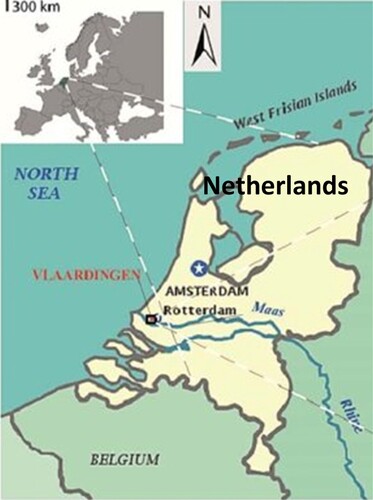
Figure 2. Metro, tram lines, concentrated in the inner city (Source: City of Amsterdam, Citation2020).
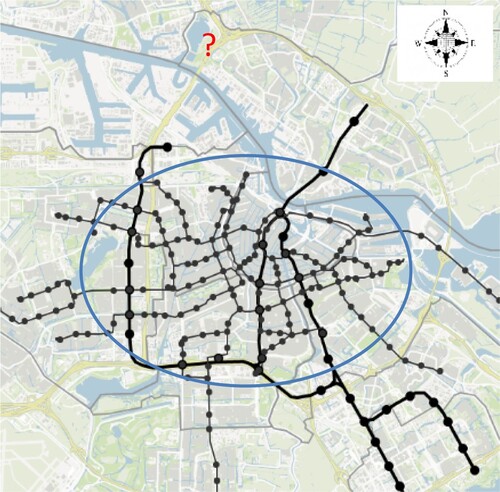
Figure 3. Location of Buiksloterham, Amsterdam (Source: Gladek et al., Citation2016).
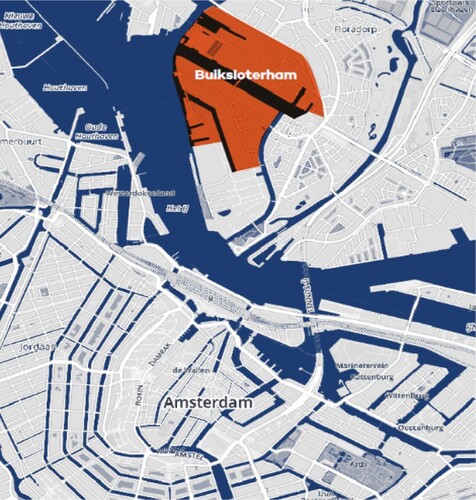
The Amsterdam Smart City (ASC) Programme was established in 2007 to facilitate sustainable use of resources and boost the creative economy by testing innovative urban solutions (Noori et al., Citation2020). A dedicated platform called ASC was developed by knowledge institutes, an energy-network operator and the municipal administration. The ASC platform was a public–private partnership, which played a role as an intermediary to broker social network ties (Raven et al., Citation2019). Being constituted by a variety of actor types, the platform worked to facilitate opportunities for initiating and testing urban experiments. The ASC expanded partnerships, fields of programmes and pilot projects from energy sectors to smart mobility, smart living, digital city and other initiatives.
Buiksloterham in Northern Amsterdam was one of the key locations for urban experiments in the field of closed cycles of power and materials on a local scale (Gladek, van Odijk, Theuws, & Herder, Citation2016). The area set its goals to be a smart, sustainable and circular neighbourhood with local energy production and resource (e.g. water and waste) management. In the context of an economic downturn, the municipality embraced a strategy of piecemeal transformations, being supportive of small-scale DIY projects that would create sustainable living and working space with circular elements. Having been developed almost from scratch, self-builders worked to establish new ways of building housing and consuming or sharing resources in a real-life environment (Baron, Citation2013; Gladek et al., Citation2016). An open platform was established to unite public agencies, private parties, knowledge institutes and self-builders (). Smart ideas and project initiators were matched with potential implementation partners.
Figure 4. Overview of the stakeholders involved in the Amsterdam Smart City (ASC) (Source: adopted from AMS, Citation2017).
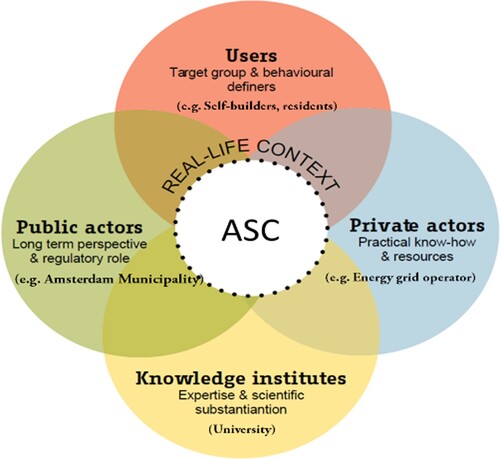
4.1.2. Assessment of the implementation process and outcomes
Analysis of the various policies and project documents of the ASC, and the interviews with key stakeholders indicated that the smart city experimentation in Amsterdam can be characterized by an open platform that enabled multi-directional information sharing and productive partnerships among multiple actors. Thanks to the emerging collective practices driven by the ASC, Buiksloterham overcame its initial weakness – e.g. lack of plans and institutional arrangements for social engagement (AMS, Citation2017). A local researcher from the knowledge institute stressed that the open platform gradually facilitated multi-directional information flow, resources sharing and social learning among a range of companies, public agencies, self-builders and knowledge institutes via on and offline. In an early phase of a project, a small number of self-builders took an initiative to establish key ideas and proactively mobilize key institutions (de Lange & de Waal, Citation2019). Later, multiple alliances among a wide range of actors at the city and local levels (as seen in ) were formed as a result of the continuous process of building up urban experiment projects and partnering for scaling-up success. The piecemeal interventions proved increasingly related and effective for the advancement of creative economies and sustainable development (Noori et al., Citation2020).
The assessment revealed that the dynamic open innovation was established in the context of self-organizing planning practice in the late 2000s. The municipality focused on institutionalizing small-scale plot-by-plot experiments for urban regeneration (Savini et al., Citation2016). City-making was considered as a temporal process that was open to modification by any actors who were willing to make efforts (Bouw & Thoma, Citation2019). In Buiksloterham, there was no typical strict zoning and development plan but included a set of rules for what people wish to develop as long as they stick to general guidelines (Gladek et al., Citation2016). A local expert involved in pilot urban experiments emphasized that focus was not on establishing a long-term fixed plan but on applying an organic approach (i.e. improvising and quickly adopting to continually changing circumstances) to respond to emergent needs and opportunities for Buiksloterham. In this context, varied actors were encouraged to be part of urban experimentations and pieces of the area were gradually re-developed by involving actors of varying sizes (e.g. housing corporations, engineers, clean tech development firms and architects) (AMS, Citation2017).
The case study indicated that while the urban experiments were based on urban entrepreneurialism, the government played a role in controlling the practice of organic planning. A piecemeal incremental strategy was supported by up-front public investments in public buildings and the municipality continued to set land-use prices and building conditions for new development (Dembski, Citation2013; Savini et al., Citation2016). In Buiksloterham, social housing projects were initiated on public lands and sustainability was conditional criteria for each building project. Environmental guidelines for area development (e.g. industry and environment zoning guideline) required self-builders and developers to adopt innovative solutions, especially for local energy provision (Dembksi, Citation2020; Mora & Bolici, Citation2017). Some of the regulations and procedures appeared to be too rigid or ambiguous and had to be adjusted or newly created in order to continuously encourage development activities (de Lange & de Waal, Citation2019).
After all, the pace of development picked up as the continuous efforts for facilitating urban living labs and the open platform attracted more people who desired to have control over their living environment (Reimerink, Citation2016). In turn, Buiksloterham involved more projects, multi-level partnerships between self-builders and private actors in the area of mobility, public space, affordable housing, water management and other circular innovation (AMS, Citation2017). The social fabric of the local actors was strengthened and knowledge and resources were shared, contributing to enhancing common values (of spaces) (Bouw & Thoma, Citation2019; Reimerink, Citation2016). Overall, in the context of emerging self-organizing planning practices and clear institutional arrangements for urban sustainability, local technology has been distributed through multi-level social networks, contributing to gradual transformation into a circular city.
4.2. Smart transportation reforms (Seoul, Korea)
4.2.1. Setting the scene
Seoul is the capital city of the Republic of Korea with a population being around 10 million (). The city is known for its drastic economic growth and rapid expansion of population from 2.5 million in 1960 to 10 million in 1990 (SMG, Citation2015). The most urgent and fundamental task of Seoul was establishing public services, especially public transportation, to support the quality of life by enhancing mobility for the Seoul Metropolitan Area (). Despite the continuous supply of public transport, social costs for severe traffic congestion continually increased, due to the increase of travel and parking for cars (SMG, Citation2015). Road congestion further degraded bus service quality, contributing to slow, late and unreliable public transit systems. In the context of declining profits and excessive competition, private bus companies tended to refuse operations in unprofitable areas (SMG, Citation2017), resulting in balanced service across the city (Kang & Lee, Citation2015). The quality of service of urban transportation got worse and car ownership continued increasing, while bus companies kept focusing on individual lucrative business. Profound improvement was urgently needed, rather than incremental adjustment. Eventually, Seoul urban transportation called for a radical reform (Lee, Citation2017).
Figure 5. Location and map of Seoul Metropolitan Area (Source: An & Wan, Citation2018) (left).
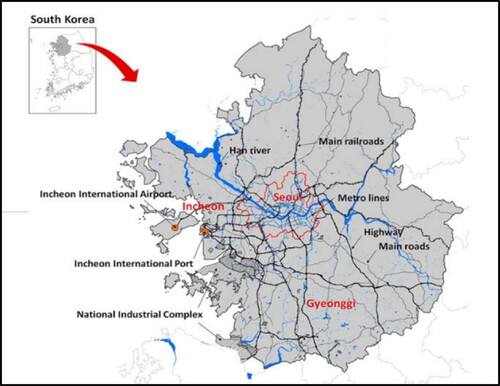
Figure 6. Commuting to Seoul from vicinity (Source: Seoul Institute, Citation2015) (right).
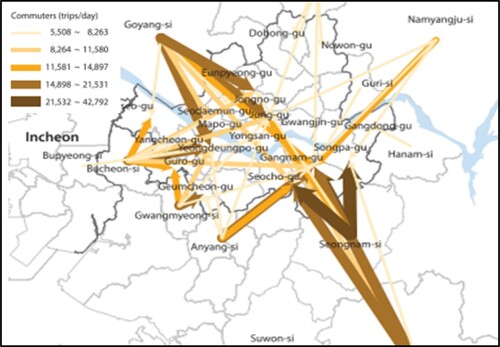
Seoul’s transportation reform, de facto smart city transportation, started in 2002, even before the term ‘Smart City’ was caught on as an international model. The fundamental goal was to shift the paradigm of urban transportation and introduce ‘a whole new public transit system’ to improve citizens’ accessibility and mobility (Kang & Lee, Citation2015). Seoul Metropolitan Government (SMG) introduced a quasi-public transportation system in order to secure the public value, as well as maintain the private bus operations (Pucher, Park, Kim, & Song, Citation2005). With support of information and communication technology, Seoul tried to adjust bus routes and upgrade operational systems in line with public interests in improving the service level of public transportation, as well as enhancing social inclusion and environmental sustainability (SMG, Citation2017).
At first, the transportation reform looked impossible because no one welcomed the reform in Seoul (SMG, Citation2017). Bus companies accused SMG of the infringement of property rights (e.g. route decision right) and management interventions. The majority of citizens, who were driving cars, fired off many complaints about the bus rapid transit and median bus lane for car-lane reduction at the congested roads. Smart city transformation required more than smart city technology in order to make a change and impact in the real world.
4.2.2. Assessment of the implementation process and outcomes
The analysis of the Seoul’s smart transportation reform indicated that key enabling mechanisms for the reform were multi-sector role-sharing among public management, private operation and the citizens, based on multi-directional communication (). Within the quasi-public transportation system, SMG was in charge of setting bus routes to properly accommodate people’s transportation demands while the actual operation of transportation service was under the control of the private operators. Public monitoring and evaluation systems played an important role in examining transportation operators’ performance, service level and contract fulfilment (Kang & Lee, Citation2015). The Bus Reform Civic Committee – i.e. an independent organization composed of key parties including civil organizations, knowledge institutes, bus companies, city council and other related entities – was set up to encourage active civic participation and prevent delays in the reform process (Yi et al., Citation2017). As a result of numerous meetings (i.e. once every week for 2 years) among the key partners (), SMG established measures to restructure the bus routes and overall operational system for the sake of citizens’ convenience and financial stability of bus companies (SMG, Citation2006; Song & Kyung, Citation2005).
The case study showed that fundamental reforms were attributed to fully integrated key information and data between the private operators and SMG. Transport experts, who were previously responsible for the bus reform, confirmed that rules for sharing and integrating key information such as revenue and occupancy among all the transit operators and SMG were vital. Passenger Automobile Operation Business Act facilitated renewed institutional arrangements that SMG and transportation operators jointly managed revenue and redistributed it (SMG, Citation2017). All the fares of public transportation including bus and subway were collected within the revenue pool management system from both profitable and unprofitable routes, and redistributed based upon a new fare-distribution rule (SMG, Citation2017). Surplus in profitable routes was used to compensate for deficits in unprofitable lines served by companies whose expenses exceeded income. Spreading their services over the entire city based on the innovative collective system, thanks to the ICT, private entities saw an increase in the profitability of their business while citizen’s welfare increased due to the wider distribution of better transportation service over the entire city.
The key public actor, SMG, played a key role in ensuring that the smart transit system significantly enhanced citizens’ access to information and services (). The government proactively established an operational platform in order to collect, distribute and monitor information on transit operation, and other data among citizen and bus companies. The interviews with a former transport officer at SMG and a public transit planner clearly revealed that gathering and releasing of all the public transportation information to the public contributed to empowering citizens to monitor the state of public transportation and be engaged in discussions that reflected priorities for further improvements. Based on monitoring and evaluation information, SMG continually took on a central role in adjusting bus lines and overall system design while maintaining competition among bus operators in order to enhance the quality and efficiency of public transit services.
Figure 8. Change in roles of public and private actors after transportation reform (Source: authors). *TOPIS: Transport Operation and Information Service.

After all, the transportation reform brought radical changes in terms of efficiency and equity in the delivery of infrastructure and services. Due to the increased speed, lowered congestion and scientific bus management, the smart transportation system increased flow speed and punctuality of services while the citizens’ public transportation cost decreased as citizens paid distance-based fare with seamless transfers among travel modes (SMG, Citation2017). Since the burden of transfer between different transportation modes became relieved by the integrated fare system, people had higher freedom to move with various transportation modes to use. All in all, the smart city initiative in Seoul made a systematic and fundamental reform by accentuating the use of ICT to achieve the better relationship and collaboration between citizens, private operators, and the government based on multi-directional transparent communication. The most important role of smart city technology was enhancement of transparency and accountability of both government and civic society.
4.3. Addressing the digital divide for smart cities (Portland, Oregon USA)
4.3.1. Setting the scene
Portland is the 10th fastest growing metropolitan area in the United States with approximately 650,000 people and a stable growth rate of 1.8% per year (World Population Review, Citation2021) (). It is well known for its progressive planning and sustainability initiatives. The City of Portland was the first in the U.S. to release a Local Action Plan on Global Warming (City of Portland, Citation1993). Portland recently became the first major city in the U.S. to build a bridge, the Tilikum Crossing, exclusively designed for public and active transportation, creating a safer route to cross the river (City of Portland, Citation2021). While progressive planning institutions advanced sustainability work, there was increasingly disparate access to infrastructure and public space. Compounding inequities in how public investments benefitted different neighbourhoods, there were racial disparities in income and poverty levels, which threatened the social and environmental security of disadvantaged communities (Coalition of Communities of Colour, Citation2008). With the quantitative realities of asset allocations coming into focus (), leaders in Portland had to rethink their processes and underlying power and distribution dynamics.
Figure 9. Portland on Northwest Map (Source: Nations Online Project, Citationn.d.).
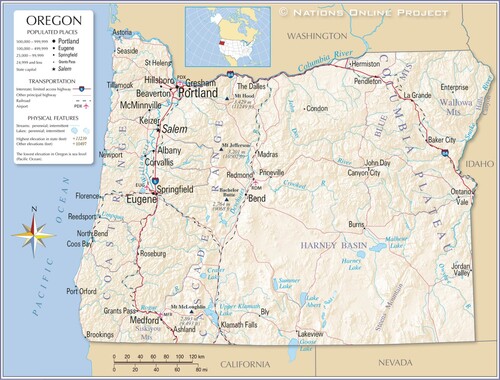
Figure 10. Average vehicle miles travelled in the Portland Metro Region (Source: MacArthur, Clifton, Broach, & Shandobil, Citation2018).
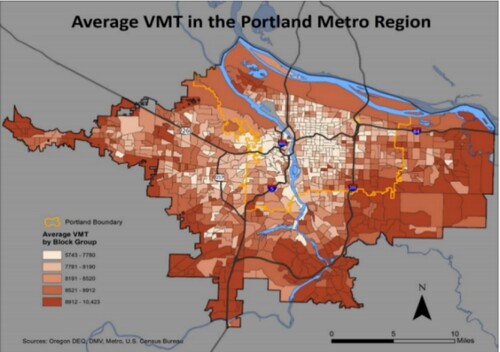
The City of Portland has come to define its approach to ‘Smart Cities’ as the ‘use of existing and innovative technologies, data collection and management tools to enhance community engagement, improve delivery of public services and address city goals around equity, mobility, affordability, sustainability, community health and safety, workforce development and resiliency’ (Kendrick & Martin, Citation2015). Smart City PDX (Citation2021) has been at the nexus of private innovation and public services, centring its programmes around equity and inclusion, data protection, security policies and technology adoption. The values embedded in the programme represented years of community outreach and engagement to better understand and address divides carved over decades of racism, disinvestment and violence. On the streets and in public forums, people seeking racial, economic and social justice have argued that inclusion must be the foundation for future public investments (Griffith, Citation2020). In that context, there was an imperative that all public funding includes the adoption of emerging technologies with public trust in mind and aligned with inclusive policies.
4.3.2. Assessment of implementation process and outcomes
For bridging the digital divide, the City of Portland has worked towards an open and people first approach to digital transformation of public services (Smart City PDX, Citation2021). Adopting an Open Data Resolution (Resolution No. 36735), which created standards for data-sharing and accountability, the city created a healthy dynamic where the public engaged and relied on data for their own analyses of everything from earthquake hazards to permits to amenities (from transportation to emergency management to parks) (City of Portland, Citation2020a). The approach to smart cities in Portland has fostered a culture of open data governance to inform and evaluate key decisions, and achieve more equitable service outcomes (Ordinance 188356, Citation2017). Smart City PDX was set in motion to expand on these commitments as formalized through foundational documents approved by the City Council including equity priorities and privacy principles (Smart City PDX, Citation2021).
The city has proactively considered the underlying desire and demand for technological adoption from basic amenities to enhanced public services. The iterative interviews with Smart City PDX staffs and working group members confirmed that one way to mirror public values was to move beyond the conventional city-contractor model to a more community-based approach to smart city development. By focusing on underserved areas as a priority, the City of Portland collaborated directly with community-based groups to address the issues most plaguing their constituents’ access to resources and wellbeing. An emergent issue continued to be an increase in traffic fatalities with 56% of traffic deaths occurring in disadvantaged groups (Portland Bureau of Transportation, Citation2020b). By building a common data framework, the City of Portland established incremental safety measures based on the data characteristics (Pollock, Citation2018).
Moreover, the government has played an important role as a broker of technology to pilot and test strategies openly for public scrutiny in order to increase access to services while also incentivizing innovation. A pilot programm of e-scooter deployment was conducted to test safety regulations and make data open so that impacts could be tracked by public and private actors and kept an open market for competition to emerge and provide direct to consumer products (Portland Bureau of Transportation, Citation2020a). Piloting smart city initiatives was an effective practice for providing all sectors an opportunity to work through issues from the design to implementation phase.
Smart City PDX was explicitly designed to assess and address emerging needs of the most marginalized group to protect public interests arising from technology adoption (i.e. digital inclusion and data governance). In respond to evolving privacy and data security concerns, sensitive information and vulnerable populations have been safeguarded through transparent, ethical and non-discriminatory protections as part of an effort to ‘reframe its mission around improving equity by being responsible with technology’ (Simonite, Citation2020). Furthermore, in the context of COVID-19, an innovative approach to rapid inclusion and enabling self-organizing planning was adopted. The interview with the members of the Collective Stakeholder group of the Digital Divide Response indicated that setting up the Digital Divide Work Group was key to advance digital inclusion for individuals those experiencing poverty and isolation. An executive team, consisting of expert representatives from marginalized groups, has collaborated with city staffs for technical assistance, internal processing and funding as well as for analysis of how to move forward and balance stakeholder priorities (City of Portland, Citation2020b; Smart City PDX, Citation2021). (). 3 million dollars of Coronavirus Aid, Relief, and Economic Security (CARES) Act funding has been allocated by the city council to invest in digital inclusion. Technology kits have been delivered to frontline communities through this new model for distributing devices utilizing community-based organizations as the conduit and service provider for follow up maintenance and training (Smart City PDX, Citation2021).
Figure 11. Digital Divide Work Group Structure for scaling-up CARES ACT Response (Source: adopted from City of Portland, Citation2020b).
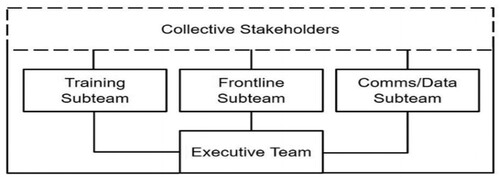
Overall, Smart City PDX provided a model for scaling-up initiatives to be responsive to citizen concerns by engaging them in both policy and project design, piloting, implementation and monitoring phases. The guiding principles set early in the smart city initiative ensured that the adoption of new technology enhanced accessibility to public services (Smart City PDX, Citation2021). During the implementation process of Smart City PDX, time and expertise of a variety of stakeholders including traditionally marginalized groups were valued in defining innovative solutions. This model served as a reminder that smart cities start at the baseline of citizen access and must be viewed through multiple lenses to enhance equity in both process and outcome.
4.4. Smart city coordination through smart ticketing system (HCMC, Vietnam)
4.4.1. Setting the scene
Located in the South of Vietnam (), HCMC is the largest city in Vietnam with approximately 9 million people, generating a fifth of the national GDP (DSO, Citation2019; GSO, Citation2019). The city has experienced rapid economic development coupled with extensive population growth over the last two decades. Due to the rapid pace of urbanization, the city has had various issues related to housing, environment, climate change and urban mobility. Urban mobility has been a key issue in HCMC, which is demonstrated by the widespread daily congestion, a limited supply of public transport and the dominance of private transport for door-to-door mobility. Buses were the only mode of public transport available serving less than 5% of total travel demand. There has been a decrease in ridership since 2013 due to the public perception of poor service quality and lack of momentum to drive the innovations with the private sector ().
Figure 13. Bus ridership in Ho Chi Minh City during 2002–2017 period (Source: MCPT, Citation2018).
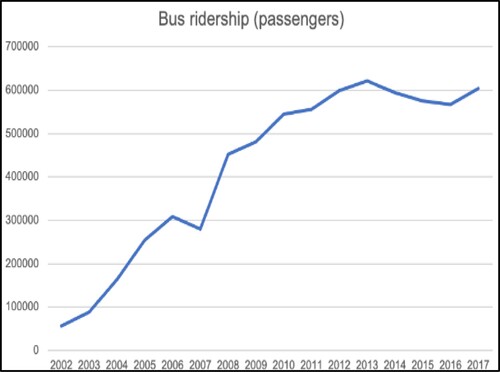
In 2013, the Master Plan for Transport Development to 2025 was enacted with a goal to increase the use of public transport up to 25–30% of the total travel demand by 2025 (Prime Minister, Citation2013) through outlining rapid transit systems and varied transport modes. The Master Plan allowed HCMC to address the challenges of public transport and called for the renovation of conventional governance mechanisms and an ineffective communication platform. In 2017, the Smart City Strategy for period 2017–2020 with vision 2025 was issued to shape the ‘establishment of the shared database and development of open data ecosystem’ (HCMC People's Committee, Citation2017) in order to push the application of new technologies, the optimization of resources and establishment of a citizen-centric governance mechanism.
HCMC has been implementing a smart mobility project (i.e. Smart Ticketing System of public transport network, called STS project) within the scope of Global Future Cities Programme funded by Foreign, Commonwealth & Development Office of the UK (UK FCDO) and with the technical assistance from UN-Habitat. Due to the interdisciplinary nature of the intervention, the Department of Transport (DOT) and Management Centre for Public Transport (MCPT) acted as key partnering stakeholders, coordinating participation from multiple stakeholders (). Aiming at establishing a technical standard framework (TSF) and proposing a workable governance system (UK FCDO, Citation2019), the STS project was expected to integrate public transport modes and provide a collaboration platform for public stakeholders (e.g. existing bus operators and BRT/MRT project owners) and private service providers (e.g. digital payment and banking service).
4.4.2. Assessment of implementation process and outcomes
The analysis of the smart mobility project revealed that initial focus was on tackling the internal issues related to limited information sharing among the city authorities and the lack of accurate data-based management. The city has called for support from the international partners and participation of the private companies in order to reach the set targets of the smart city strategy (People Committee of HCMC, Citation2017). The interviews with a project manager and transport officers involved in the STS indicated that the key driver of urban innovation in HCMC was to establish several capacity building activities fully integrated into the project implementation. Several capacity building activities were arranged to equip authorities staffs with essential knowledge and skills to adopt and maintain the proposed TSF and to coordinate ongoing public transport projects in HCMC (UK FCDO, Citation2019; UN-Habitat, Citation2019a). As a core component of project, the capacity building focused on not only equipping the knowledge but also engaging the members of the city’s technical working group (TWG) (e.g. DOT and MCPT) with international partners and private STS services providers. Such activities ensured the shared understanding of common values, individual resources and responsibilities among stakeholders.
Moreover, the STS project applied a learning by doing approach to smart city transitions – e.g. piloting smart mobility projects, building trust and a collaborative discussion among different stakeholders from both public and private sectors. The key stakeholders involved in the STS intervention emphasized that creating a dedicated TWG and involving proactively private service providers into the planning process of pilot projects was vital. With the implementation of pilot projects, the STS project gradually triggered the integrations of related activities and projects, creating an integrated planning platform over time. Stakeholders had a chance to explore the mutual gains and recognition of their interdependence and shared ownership regarding the city’s smart ticketing system. This process of multi-sector engagement in the early phase contrasted with the conventional approach of project design and implementation.
As the STS knowledge and trust among stakeholders increased, the small scope of integration (i.e. internal collaboration amongst sectoral departments) gradually triggered a larger scope (i.e. establishing collaborative mechanisms with business entities and open platforms to engage new service providers) (). Through the regular meetings and occasional workshops co-organized by FCDO, DP and the city authorities, STS process gradually strengthened relationships among stakeholders and increased the number of partners joining the platform and discussions in order to improve outcomes. Previously, city authorities worked mainly in silos or with limited coordination, but the STS project led to a process which created inroads to collaborate internally and externally. However, it is worth to note that the presence of academies and NGOs in the STS project has still been limited since their expertise in this area was still emerging and the role was not yet been clearly identified.
Overall, the project has gradually generated collective practices among the stakeholders, enhancing technical capacity regarding new technologies of city authorities, and upscaling coordination efforts for public transport development. The project recognized the vulnerable groups as one of many end-users or beneficiaries of smart ticketing and in turn increased the service provision opportunities for the private sector enterprises (Macdonald, Citation2020). More precisely, the project had made efforts to investigate how to support vulnerable groups over the long-term by enabling fare discount policies for targeted users. If successful, it will enhance the convenience level of all public transport modes and the perceived reliability of transport services. In the long-term, it will create behavioural changes of not only public transport users but also service providers, contributing to overall ridership and distribution of accessibility to jobs and services across the city.
5. Analysis of commonalities and context-specific approaches of selected cases
5.1. Smart city transition with an integrated platform
The case studies illustrated that smart cities represent a dynamic process of transformation where most cities start with practical applications to enhance basic services ranging from public transit to broadband access, security enhancement and resource management. The smart city initiative gradually advanced city goals around sustainability, equity and affordability by reinforcing engagement of multiple actors.
All the case studies reveal that an integrated platform can play a role of middleware in enabling collective governance across sectors and at multiple levels, accelerating the smart city transition and activating a network of actors for its implementation. Facilitating open and multi-directional information flows among stakeholders – e.g. city to citizen, citizen to citizen, citizen to city – the smart city initiatives addressed emergent, temporal and diverse social issues. Each case study showed the importance of the affordance and transparency of systems and the condition of being open to change from within or the outside (de Lange & de Waal, Citation2019). In Amsterdam, establishing open platforms facilitated the continuous processes of exchanging, merging, and sharing ideas and resources and finally upscaling sustainability experimentation among stakeholders. In the case of Seoul and Portland, open governance and integrated communication systems were foundational to building public trust and accountability and engaging citizens in technology applications that benefit their wellbeing. The government in HCMC expanded the mechanism of engagement by piloting open platforms for both private and public sectors. Each case illustrated that the shift to more collaborative governance took time. As a variety of stakeholders learned to work together in an informal atmosphere, mutual trust and collective practices became the norm.
Our research shows that smart transitions are not enacted only by citizen participation nor top-down process, but often take a hybrid formation to effectively engage actors at multiple levels (Luque-Ayala & Marvin, Citation2015). The notion of top-down and bottom-up does not adequately reflect the complexity of issues at play. In Seoul and HCMC, the strong intervention of the city governments to properly accommodate citizen’s transportation demands was fundamental for significant increase in accessibility and mobility across a city. In the case of Amsterdam, the municipal government played an important role in controlling the organic planning practice by establishing specific environmental and social norms for development projects in order to ensure sustainable and equitable benefits to localities. The city government in Portland proactively developed foundational principles with commitments to a public process to ensure there was buy-in and accountability from the beginning about the city government’s role in ensuring equitable outcomes. Each case shewed that aligning a macro-level policy with public values is critical to reach equitable outcomes from the smart city initiatives.
5.2. Context-specific approaches
The way smart city transitions happen is indispensably linked to the socio-economic, cultural and institutional contexts. Each of the selected cities took different approaches to establishing an integrated platform in order to address specific ‘pre-existing’ socio-economic issues within an institutional context of a city. In the case of Amsterdam, various actors including the municipal government, self-builders, knowledge institutes and entrepreneurs established multiple open platforms that enacted a multitude of small-scale collaborations among the stakeholders. Being characterized by contingency and multiplicity, such a governance model enabled the diverse actors to co-produce and expanded desired values (circular innovation) out of urban sustainability experiments.
In Seoul, for the fundamental reform of public service, the metropolitan government proactively established a centrally-controlled platform, through which the government created innovation with private operators and facilitated collective decision-making processes among a wide range of stakeholders. Through the centralized operations, the public actors incentivized the innovation in public service to accommodate citizens’ demands for better access to the whole information and service. Based on a transparent and integrated information system, the quality of the service was fully monitored and improved.
With commitments to equity, open data and privacy protections, the City of Portland focused on establishing a community-centred platform. To address the serious issue of increasing digital divides, the city government built a strategic relationship with actively working community-based organizations. The organizations played key roles as intermediaries – i.e. identifying urgent needs, providing technology training and facilitating a process for distribution. The strong collaborative relationship between the city government and the key organizations enabled marginalized groups to access information and participate in planning.
In the case of HCMC, smart city initiatives focused on building two-track platforms, in which internal and external collaborations were established simultaneously. Such two tracks were essential to accelerate the capacity building of public actors at the same time as collaboration with multiple external partners in order to receive public and private inputs. The governance model gradually enabled all the key stakeholders (e.g. public agencies, private companies, international organizations and community groups) to set up common ground and shared ownership for smart city transitions.
After all, critical elements and processes for sustainable and inclusive smart city transitions vary, according to socio-economic agenda, and would benefit from leveraging available resources and capacities of actors and building on emergent local networks. Our research provides context-specific lessons for smart city development that start with seeing systemic changes and right-sized solutions to real-life situations. First, institutionalization of small-scale organic plot-by-plot approaches to urban experimentations can provide opportunities for facilitating inclusive urban transformation, especially when large-scale planning does not work within the context of limited financial resources or the need to distinguish unique community assets. As seen in the case of Amsterdam, the gradual and organic transformation process can leave room for both small and large actors to invest in development. Capacity for strategic mobilization (e.g. identifying an institution who supports innovative ideas of a small number of citizens) in the early stage is essential for initiating smart city projects. Upscaling smart city projects by sharing information, knowledge and resources and partnering via a variety of platforms is a key to increase benefits for individuals while strengthening the commons.
Second, creating fair distribution of benefits across the whole city may require a full-fledged systemic reform as it can produce a significant synergistic effect. Depending on the priorities, urgency, and the scale of urban issues to tackle, a radical reform can turn out to be more effective, instead of incremental adjustment. For bus reform cases like Seoul, opening and integrating the whole system is necessary to make breakthrough achievement when a city cannot escape from the tragedy of the commons as private actors focus on profit only and all become losers. Distributing quality services over the entire city with the solid belief of benefits-sharing thanks to the ICT, both profitability of service and societal benefits increases.
Third, in some cases, creating an ecosystem for innovation may require advanced institutional measures in place to protect citizens’ rights and security, especially those who are most vulnerable. As seen in Portland, a city first needs to address equity issues such as WiFi affordability for the most vulnerable groups in order to have a responsive marketplace of ideas and meet basic user needs to join digital networks. The case suggests that it is critical to conduct pilots open to public scrutiny as part of adoption process, ensure technology is developed through a mix of public and private actors (especially, small, local contractors), and establish a coalition of community-based organizations for increasing digital transformation, access and connection.
Fourth, when there is institutional fragmentation and a lack of collaborative practice at public authorities as in the case of HCMC, there is a necessity of having a step-by-step approach to expanding an open innovation ecosystem. The initial focus needs to be on enhancing coordination and integration within the city government. Next, with the capacity building for external collaboration, city authorities can proactively engage with diverse partners in implementing and monitoring pilot projects. In this process, open ecosystems and knowledge networks are gradually established, engaging new service providers.
All in all, ‘smart city’ has a strong connotation for technological, organizational and social innovation processes. The success of smart city initiatives must be built on the broader socio-economic and institutional contexts of a city over time, in order to gradually shape shared ownership and ensure public goals are met.
6. Discussion and conclusions
Overall, our research advances current academic and policy discussions on smart city transitions, especially, as a social transition towards more inclusive development through technology. First, our research indicates that there needs to be a more nuanced understanding of the varied forms of socio-technical transitions that facilitate inclusive urban transformation. Considering pre-existing strategic concerns of cities, incumbent actors’ networks, regional-specific resources and local institutional structures and capacities are critical to determine what are the appropriate and practical processes and elements for smart city transitions (Raven et al., Citation2019). The strategy for smart city initiatives should be flexible, contingent and practical to solve the wicked problem of a particular city, rather than sticking to a formulaic one-size fits all approach. What matters is that smart city transitions ultimately contribute to enabling more equitable and resilient urban change (e.g. Castelnovo et al., Citation2016; Durose et al., Citation2019; Kitchin, Citation2019).
The case studies point out that smart city processes do not follow black and white logic. In practice, distinction between bottom-up social processes and technology-led top-down approach is often subtle as Joss et al. (Citation2019) emphasized. Smart city transitions tend to be multi-level endeavours mediated through open governance systems and integrated platforms in order to address citizen’s varied needs for better and equitable access to public services. In this context, discussions on smart cities should move beyond arguing for an ideal process of urban transformation based on the Western-oriented theorization of smart urbanism (Shelton et al., Citation2015). As emphasized by Luque-Ayala and Marvin (Citation2015), there is an urgent need to critically engage with why, how, for whom, and with what consequences smart city transitions are emerging in different settings. What is necessary is to explore differential expression of smart city transitions across the globe and the potentials to develop more contested forms of knowledge, rather than sticking to pre-defined logics of smart city development.
In conclusion, building an inclusive, integrated and multi-level planning approach is a prerequisite for effective and sustainable transformation into smart cities. Based on our in-depth engagement with the four cases, it is our firm belief that with an integrated approach to data and information collection and management, citizen engagement, social capital, hard infrastructure and digital technologies can work together to make cities more inclusive and resilient. The way that smart city transitions are enacted varies among cities across the globe, depending on their broad socio-economic agenda and local contexts. There should be open-ended and interdisciplinary lenses through which smart cities are assessed and discussed. In practice, the open and collective co-creation processes for smart city transitions can be a cycle of trial and error rather than a linear path progression. It can be a slow process to norm agreements between public and private sector actors and reach appropriate terms that serve the public good. In any case, the design, access and control of smart cities must be open, transparent and distributed fairly in both process and outcome. They are complex and dynamic and only possible when leveraged through collective efforts.
Disclosure statement
No potential conflict of interest was reported.
Correction Statement
This article has been corrected with minor changes. These changes do not impact the academic content of the article.
Additional information
Funding
References
- Amsterdam Institute for Advanced Metropolitan Solutions. (2017). Urban living labs: A living lab way of working. Delft: Delft University of Technology.
- An, Y., & Wan, L. (2018). Modelling industrial firm relocation with impacts of spatial dependence. International Journal of Urban Sciences, 22(1), 80–103.
- Babbies, E. (2010). The practice of social research. Belmont: Wadsworth.
- Baron, G. (2013). ‘Smartness’ from the bottom up: A few insights into the Amsterdam Smart City programme. Metering International, 3, 98–101.
- Bouw, M., & Thoma, D. (2019). Economic resilience through community-driven (real estate) development in Amsterdam-Noord. In M. de Lange & M. de Waal (Eds.), The Hackable city (pp. 119–127). Singapore: Springer.
- Bulkeley, H., Coenen, L., Frantzeskaki, N., Hartmann, C., Kronsell, A., Mai, L., & Voytenko, Y. (2016). Urban living labs: Governing urban sustainability transitions. Current Opinion in Environmental Sustainability, 22, 13–17.
- Caprotti, F., & Cowley, R. (2016). Interrogating urban experiments. Urban Geography, 40(2), 1441–1450.
- Cardullo, P., & Kitchin, R. (2019). Smart urbanism and smart citizenship: The neoliberal logic of ‘citizen-focused’ smart cities in Europe. Environment and Planning C: Politics and Space, 37(5), 813–830.
- Castelnovo, W., Misuraca, G., & Savoldelli, A. (2016). Smart cities governance: The need for a holistic approach to assessing urban participatory policy making. Social Science Computer Review, 34(6), 724–739.
- City of Amsterdam. (2020). Tram and metro network. https://maps.amsterdam.nl/trammetro/?LANG=en
- City of Portland. (1993). Global warming reduction strategy. https://www.portland.gov/sites/default/files/2019-08/global-warming-reduction-strategy-nov-1993.pdf
- City of Portland. (2020a). 2020 open data handbook. https://www.smartcitypdx.com/open-data-program
- City of Portland. (2020b). Addressing the digital divide work group charter. https://static1.squarespace.com/static/5967c18bff7c50a0244ff42c/t/5f6bd90d0c2b2e695e3d7acc/1600903438158/COVID-19+Response+Digital+Divide+Work+Group+Charter+August+2020.pdf
- City of Portland. (2021). Portland bureau of transportation. Tilikum crossing: Bridge of the people webpage. https://www.portlandoregon.gov/transportation/68548
- Coalition of Communities of Color and Portland State University. (2008). Communities of color in Multnomah county: An unsettling profile. https://www.portlandoregon.gov/civic/article/505484
- Coenen, L., Benneworth, P., & Truffer, B. (2012). Toward a spatial perspective on sustainability transitions. Research Policy, 41, 968–979.
- Cowley, R., & Caprotti, F. (2019). Smart city as anti-planning in the UK. Environment and Planning D: Society and Space, 37(3), 428–448.
- Cowley, R., Joss, S., & Dayot, Y. (2018). The smart city and its publics: Insights from across six UK cities. Urban Research & Practice, 11, 53–77.
- de Lange, M., & de Waal, M. (2019). The Hackable city: Digital media and collaborative city-making in the network society. Springer. doi:10.1007/978-981-13-2694-3.
- Dembksi, S. (2020). Organic approaches to planning as densification strategy? The challenge of legal contextualisation in Buiksloterham, Amsterdam. The Town Planning Review, 91(3), 283–303.
- Dembski, S. (2013). Case study Amsterdam Buiksloterham, the Netherlands: The challenge of planning organic transformation. Context Report, 2. Amsterdam: University of Amsterdam. https://pure.uva.nl/ws/files/1523659/124693_CONTEXT_Report_2.pdf
- Department of Statistics Office of Ho Chi Minh City – DSO. (2019). Statistical yearbook of Ho Chi Minh City 2018. Ho Chi Minh City: DSO.
- Durose, C., Escobar, O., Gilchrist, A., Agger, A., Henderson, J., van Hulst, M., & van Ostaijen, M. (2019). Socially smart cities: Making a difference in urban neighbourhoods. https://www.smart-urban-intermediaries.com/wp-content/uploads/2019/11/Socially-Smart-Cities-Report-2019.pdf
- Evans, J., Karvonen, A., & Raven, R. (2016). The experimental city. London: Routledge.
- General Statistics Office of Vietnam - GSO. (2019). Statistical yearbook of Vietnam 2019. Hanoi: GSO.
- Giffinger, R., & Lü, H. (2015). The smart city perspective: A necessary change from technical to urban innovation. Milan: Fondazione Giangiacomo Feltrinelli.
- Gladek, E., van Odijk, S., Theuws, P., & Herder, A. (2016). Transitioning Amsterdam to a circular city: Circular Buiksloterham vision and ambition. https://buiksloterham.nl/
- Griffith, A. Oregon public broadcasting. https://www.opb.org/article/2020/12/31/an-exceptional-year-or-the-new-normal-a-pandemic-protests-and-then-the-state-caught-fire/
- Haarstad, H., & Wathne, W. (2019). Smart cities as strategic actors: Insights from EU lighthouse projects in Stavanger, Stockholm, and Nottingham. In A. Karvonen, F. Cugurullo, & F. Caprotti F (Eds.), Inside smart cities: Place, politics and urban innovation. Routledge. https://www.taylorfrancis.com/chapters/edit/10. 4324/9781351166201-7/smart-cities-strategic-actors-h%C3%A5vard-haarstad-marikken-wathne
- Hollands, G. (2015). Beyond the corporate smart city? Glimpses of other possibilities of smartness. In S. Marvin, A. Luque-Ayala, & C. McFarlane (Eds.), Smart urbanism: Utopian vision or false Dawn? Routledge. https://www.taylorfrancis.com/chapters/edit/10. 4324/9781315730554-11/beyond-corporate-smart-city-robert-hollands
- Joss, S., Sengers, F., Schraven, D., Caprotti, F., & Dayot, Y. (2019). The smart city as global discourse: Storylines and critical junctures across 27 cities. Journal of Urban Technology, 26(1), 3–34.
- Kang, M., & Lee, C. (2015). Smart city: A comparative perspective. Journal of Korean Regional Development Association, 27(4), 45–63.
- Karvonen, A., & van Heur, B. (2014). Urban laboratories: Experiments in reworking cities. International Journal of Urban and Regional Research, 38, 379–392.
- Kelly, S. (2010). Qualitative interviewing techniques and styles. In I. Bourgeault, R. Dingwall, & R. de Vries (Eds.), The Sage handbook of qualitative methods in health research. Sage Publications. doi:10.4135/9781446268247.n17
- Kendrick, C., & Martin, K. (2015). Portland's smart cities evolution. https://static1.squarespace.com/static/5967c18bff7c50a0244ff42c/t/5ad9235ef950b729ea0aeca6/1524179809443/isocarp-review-article.pdf
- Kitchin, R. (2019). Toward a genuinely humanizing smart urbanism. In C. Paolo, F. D. Cesare, & K. Rob (Eds.), The right to the smart city (pp. 193–204). Emerald Publishing Limited. https://www.emerald.com/insight/publication/doi/10. 1108/9781787691391
- Kluiving, S., de Ridder, T., van Dasselaar, M., Roozen, S., & Prins, M. (2016). Soil archives of a Fluvisol: Subsurface analysis and soil history of the medieval city centre of Vlaardingen, the Netherlands – an integral approach. SOIL, 2(2), 271–285.
- Kourtit, K., Elmlund, P., & Nijkamp, P. (2020). The urban data deluge: Challenges for smart urban planning in the third data revolution. International Journal of Urban Sciences, 24(4), 445–461.
- Lee, J., Arts, J., & Vanclay, F. (2020). Examining social outcomes from urban transport infrastructure: Long-term consequences of spatial changes and varied interests at multiple levels. Sustainability, 12(15), 1–21.
- Lee, K. (2017). History of transport policy of Seoul. Seoul: Seoul Development Institute.
- Luna-Reyes, L., & Gil-Garcia, J. (2014). Digital government transformation and internet portals: The co-evolution of technology, organizations, and institutions. Government Information Quarterly, 31(4), 545–555.
- Luque-Ayala, A., & Marvin, S. (2015). Developing a critical understanding of smart urbanism? Urban Studies, 52(12), 2105–2116.
- MacArthur, J., Clifton, K., Broach, J., & Shandobil, B. (2018). Environmental and equity scenarios for alternative fuel vehicle ownership and use in the Portland region. Portland: Transportation Research and Education Centre. Portland State University. https://pdxscholar.library.pdx.edu/cgi/viewcontent.cgi?article=1181&context=trec_reports
- Macdonald, M. (2020). Implementation report of smart ticketing system project. Ho Chi Minh City: Mott Macdonald.
- Management Centre of Public Transport - MCPT. (2018, August). Public transport in Ho Chi Minh City: Situation, orientation and solutions. Presentation for the consultation workshop of global future cities programme.
- March, H. (2018). The smart city and other ICT-led techno-imaginaries: Any room for dialogue with degrowth? Journal of Cleaner Production, 197(2), 1694–1703.
- McFarlane, C., & Söderström, O. (2017). On alternative smart cities: From a technology-intensive to a knowledge-intensive smart urbanism. City, 21, 312–328.
- Meijer, A., & Thaens, M. (2018). Quantified street: Smart governance of urban safety. Information Polity, 23(1), 29–41.
- Mora, L., & Bolici, R. (2017). How to become a smart city: Learning from Amsterdam. In A. Bisello, D. Vettorato, R. Stephens, & P. Elisei (Eds.), Smart and sustainable planning for cities and regions. SSPCR 2015. Green Energy and Technology. Springer. doi:10.1007/978-3-319-44899-2_15
- Mosannenzadeh, F., & Vettoriato, D. (2014). Defining smart city. A conceptual framework based on keyword analysis. TeMa—Journal of Land Use, Mobility and Environment, 6, 683–694.
- Musterd, S. (2004). Amsterdam as a creative cultural knowledge city: Some conditions. Built Environment, 30(3), 225–234.
- Nations Online Project. (n.d.). Map of Oregon. https://www.nationsonline.org/oneworld/map/USA/oregon_map.htm
- Noori, N., Hoppe, T., & de Jong, M. (2020). Classifying pathways for smart city development: Comparing design, governance and implementation in Amsterdam, Barcelona, Dubai, and Abu Dhabi. Sustainability, 12(10), 4030.
- OECD. (2019). 1st OECD roundtable on smart cities and inclusive growth. Author. https://www.oecd.org/cfe/regionaldevelopment/OECD-Roundtable-on-Smart-Cities-and-Inclusive-Growth_Issues-Note.pdf
- Ordinance 188356. (2017). City of Portland “addressing the digital divide work group charter”. https://static1.squarespace.com/static/5967c18bff7c50a0244ff42c/t/5f6bd90d0c2b2e695e3d7acc/1600903438158/COVID-19(Response ( Digital ( Divide ( Work ( Group ( Charter ( August(2020.pdf
- People Committee of Ho Chi Minh City. (2017). Decision No. 6179/QĐ-UBND on 23 November 2017 on the Smart City Strategy of Ho Chi Minh City during 2017-2020 period with vision toward 2025. HCMC. CPC.
- Phibbs, S., York, E., Ponco, J., Sifuentes, J., & Irvin, V. (2019). Building social resilience through public health practice in Oregon. Oregon Health Authority. https://www.oregon.gov/oha/PH/HEALTHYENVIRONMENTS/CLIMATECHANGE/Documents/2020/Social-Resilience-Study-Brief-FINAL.pdf
- Pollock, E. (2018, July). Portland installs smart city sensors to reduce traffic. https://www.engineering.com/BIM/ArticleID/17244/Portland-Installs-Smart-City-Sensors-to-Reduce-Traffic-Deaths.aspx
- Portland Bureau of Transportation. (2020a). E-Scooter findings report. https://www.portland.gov/sites/default/files/2020/pbot_e-scooter_report_final.pdf
- Portland Bureau of Transportation. (2020b). Saving lives with safe streets. Vision zero traffic crash report 2019. https://www.portland.gov/sites/default/files/2020-05/2019-traffic-crash-report.pdf
- Prime Minister of Vietnam. (2013). Decision 568/QĐ-TTg on 8 April 2013 on the approval of transportation master plan of Ho Chi Minh City to 2020 with vision toward 2030.
- Pucher, J., Park, H., Kim, M., & Song, J. (2005). Public transport reforms in Seoul: Innovations motivated by funding crisis. Journal of Public Transportation, 8(5), 41–62.
- PwC. (2019). Creating the smart cities of the future, A three-tier development model for digital transformation of citizen services. PWC. https://www.pwc.com/gx/en/sustainability/assets/creating-the-smart-cities-of-the-future.pdf
- Raven, R., Sengers, F., Spaeth, P., Xie, L., Cheshmehzangi, A., & de Jong, M. (2019). Urban experimentation and institutional arrangements. European Planning Studies, 27(2), 258–281.
- Reimerink, L. (2016). How Amsterdam turned a polluted industrial site into its most interesting neighbourhood. https://www.eco-business.com/news/how-amsterdam-turned-a-polluted-industrial-site-into-its-most-interesting-neighborhood/
- Repette, P., Sabatini-Marques, J., Yigitcanlar, T., Sell, D., & Costa, E. (2021). The evolution of city-as-a-platform: Smart urban development governance with collective knowledge-based platform urbanism. Land, 10(1), 33.
- Savini, F., Boterman, W., van Gent, W., & Majoor, S. (2016). Amsterdam in the 21st century: Geography, housing, spatial development and politics. Cities, 52, 103–113.
- Sengers, F., Spaeth, P., & Raven, R. (2018). Smart city construction: Towards an analytical framework for smart urban living labs. In S. Marvin, H. Bulkeley, Q. Mai, K. McCormick, & P. Voytenko (Eds.), Urban living labs: Experimentation and socio-technical transitions (pp. 74–88). London: Routledge.
- Seoul Institute. (2015). Seoul statistical series.
- Shelton, T., Zook, M., & Wiig, A. (2015). The ‘actually existing smart city’. Cambridge Journal of Regions, Economy and Society, 8(1), 13–25.
- Simonite, T. (2020). Wired magazine. “Portland face recognition ban twist on smart cities”. https://www.wired.com/story/portlands-face-recognition-ban-twist-smart-cities/
- Smart City PDX. (2021). City of Portland. https://www.smartcitypdx.com /
- SMG. (2006). Cheonggyecheon restoration white paper. Seoul: Author.
- SMG. (2015). Sync Seoul. Seoul: Author.
- SMG. (2017). Reforming public transportation in Seoul. Seoul: Author.
- Song, S., & Kyung, K. (2005). Seoul bus reform and conflict management. Seoul: Seoul Institute.
- UK FCDO. (2019). Term of references “development of smart ticketing system for public transportation network in Ho Chi Minh City, Vietnam”. Author.
- UN-Habitat. (2018). Global future cities programme. City context report. Ho Chi Minh City: Author.
- UN-Habitat. (2019a). City context report. Ho Chi Minh City: Author.
- UN-Habitat. (2019b). The future of smart and inclusive cities. Author. https://unhabitat.org/sites/default/files/2019/10/future_of_ap_cities_report_2019_compressed.pdf
- Vanclay, F., Baines, J., & Taylor, C. N. (2013). Principles for ethical research involving humans: Ethical professional practice in impact assessment Part I. Impact Assessment and Project Appraisal, 31(4), 243–253.
- World Population Review. (2021). https://worldpopulationreview.com/en/us-cities/portland-or-population
- Yi, C., Lee, C., & Jung, Y. (2017). Developing transport infrastructure in Seoul: Planning implications on Jakarta, Manila, and Ho Chi Minh city. Seoul: Seoul Institute.
- Yin, R. (2003). Case study research: Design and methods (3rd ed.). Thousand Oaks: Sage.
- Yin, R. (2009). Case study research: Design and methods (4th ed.). Thousand Oaks: Sage.

